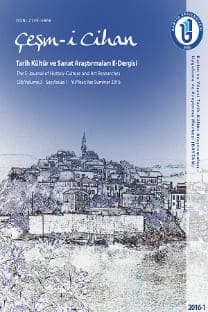YARATICILIKTA SEZGİSEL SÜRECİ ODAĞINA ALAN BİR SANATÇI; CRYSTAL WAGNER
Sanatsal yaratım sürecinde her sanatçı farklı bir tecrübe ile öznel bir deneyim süreci yaşar. Kullanılan malzeme, teknik ve üretim olanaklarına bağlı olarak sanatçı, duygu ve düşüncelerini en etkili şekilde yansıtmaya ve sanatsal pratiklerini oluşturmaya çalışır. Bu araştırmada, sanatsal yaratım sürecinde sezgisel bakışın etkisine dair eser analizi yaratıcılık bağlamında ve Crystal Wagner özelinde değerlendirilmiştir. Bu değerlendirme kapsamında, Wagner’ın çağdaş sanatın çarpıcı özelliklerini içinde barındıran büyük boyutlu dış mekân heykel üretimlerini odağına almasının yanı sıra sanatçının disiplinlerarası çalışmaları da ortaya koyulmaktadır. Üretimlerinde farklı malzemeleri kullanan sanatçı, baskıresim alanında aldığı eğitim ile mekâna göre şekillendirdiği heykeller aracılığı ile özgün üretimlerde bulunmaktadır.
Sanatçının sezgisel olarak önceden belirlediği bir mekâna ve atmosfere uygun olarak tasarladığı çalışmaları o “an” a dair yaratıcılık çözümlemelerini de beraberinde getirmektedir. Ancak sanatçı bu öngörülemez durumu bir gerilim veya kaygı sorunsalı olarak görmez. Bu durum, Wagner için spontanlık ve yaratıcılığın sezgisel olanaklarının deneyimlenmesi biçiminde yorumlanmaktadır. Bilinçli bir spontanlığın hissedildiği büyük ölçekli enstalasyonlarında sanatçı, cesur renkleri ile ilgi çekici bir mekân deneyimi ortaya çıkarması üretim sürecinde yoğun emek odaklı çalışmasının da bir yansıması olarak değerlendirilebilinir.
PROPHET MOHAMMAD AND CALIPH ALI IN THE “DEDE QORQUT RUMOR” COLLECTED IN ZANJAN
The information about Dede Qorqut, who is accepted as the narrator of the Dede Qorqut Epics, is included both in his narrations in the introduction section of the Book of Dede Qorqut and in some historical sources and oral narrations. One of the oral narrations is the “Dede Qorqut Rumor” compiled from Âşık Ferruh Bayat, who lives in the city of Zanjan, Iran today. In the first part of this rumor, which consists of 4 parts, various features of Dede Qorqut such as being a nebi (prophet) or dervish and having a say over the Turks are mentioned. In the second part, it is explained that Dede Qorqut went to Mecca and met with Prophet Mohammad and became a Muslim, and after learning the methods of Islam, he returned to Azerbaijan and conveyed Islam to the Turks. The third part includes the interpretation of why Ali was not given the caliphate, which he claims after Prophet Mohammad's death. In the last part, after the caliphate was not given to Ali, it includes Dede Qorqut's defense of his right to the caliphate, with the poems he read and the epics he told, making a qopuz. While some of the information about Dede Qorqut mentioned in the narration are similar to those in the Book of Dede Qorqut and in historical sources, some of them are not in the mentioned sources. These parts have been shaped by the political and religious structure of Iran. For example, Dede Qorqut's performance of his art to defend Ali's rights can be considered in this context. It is also known that Iranian Turks used Dede Qorqut as a tool in the construction and protection of their national identity. Therefore, this narration, which is important for the construction and protection of national identity apart from the religious and political structure of the region where the text was compiled, has been examined on the basis of these three elements. As a result, we think that this narration, which is compiled from Zanjan and contains Dede Qorqut's meeting with Mohammad, inventing saz (a stringed instrument) and defending Ali in his performances with it, will contribute to Dede Qorqut's studies in terms of containing information about different features of Dede Qorqut.
___
- Azzarello, Nina. “Crystal Wagner wraps an amorphous growth around art nouveau building in lodzd” (21 Ekim 2016). Erişim 03 Kasım 2021. https://www.designboom.com/art/crystal-wagner-hyperbolic-art-installation-lodz-poland-10-21-2016/
- Danto, Artur C. Sanatın sonundan sonra: Çağdaş sanat ve tarihin sınır çizgisi. Çev. Zeynep Demirsu. İstanbul: Ayrıntı Yayınları, 2014.
- Erman, Maria. “Crystal Wagner recycles single-use materials into gigantic colorful sculptures” (08 Ağustos 2018). Erişim 03 Kasım 2021. https://www.designboom.com/ art/crystal- wagner- recycle- single-use-materials-gigantic-colorful-installations-08-08-2018/
- Günöz, Önen. Mimari tasarım stüdyolarında sezgisel bilginin mimarlık bilgisine dönüşümü. Yüksek Lisans Tezi. İstanbul Teknik Üniversitesi, 2008.
- https://ajournal.blog/Ajournal/Icerik/sezgisel-dunyayi-insa-etmek.
- Kurt, İlkin. “Sezgisel Dünyayı İnşa Etmek” (31 Mayıs 2018). Erişim 03 Kasım 2021.
- Önder, Aydın. Modern heykel sanatında yaratıcılık. Yüksek Lisans Tezi, Anadolu Üniversitesi, 2005.
- San, İnci . "Sanat ve Yaratıcılık Eğitimi Olarak Tiyatro". Ankara University Journal of Faculty of Educational Sciences (JFES) 18 / 1 (Eylül 2019): 99-112 .
- Soyer, Makbule Kalı- Keskinoğlu, Muhammet Şerif - İme, Yakup. “Kişilik Özelliklerinin Karar Verme Stilleri ve Yaratıcı Düşünmeyi Yordama Düzeyleri”. İnönü Üniversitesi Eğitim Fakültesi Dergisi 22/ 2 (Ağustos 2021): 1828-1863.
- TG, Treason Gallery. “Crystal Wagner” (ts.) . Erişim 03 Kasım 2021. https://treasongallery.com/crystal-wagner
- VH, Voyage Houston. “Art & Life with Crystal Wagner” (5 Aralık 2018). Erişim 03 Kasım 2021. http://voyagehouston.com/interview/art-life-crystal-wagner/
- Yetişken, Hülya. Estetiğin ABC'si, İstanbul: Kabalcı Yayınevi, 1998.
